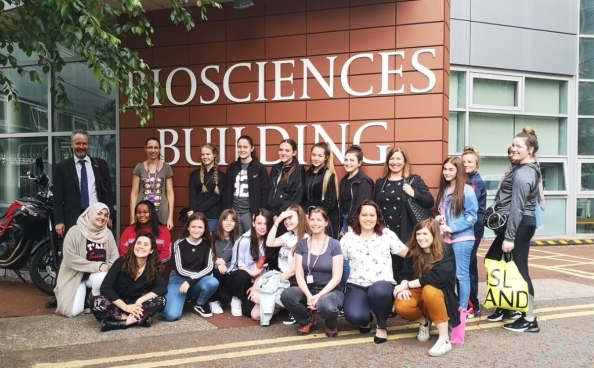On Saturday 17th March IIB led the Meet the Scientists Event at the World Museum. Activities included stands led by the CCI and Madine group from IIB along with other stands from Life Sciences, ITM and IGH.
The CCI had a large team, and all worked together brilliantly on the Seeing is Believing stand! The team included:
Violaine See (CCI staff): Preparation of samples for imaging, and assistance at the event.
Dave Mason (CCI staff): Preparation of samples, imaging of samples, produced posters for the event, and assistance at the event.
Marco Marcello (CCI staff): Organisation of virtual reality tours of microscopy images, with Virtual Arcade
Daimark Bennett (CCI staff): Preparation of samples for imaging, and assistance at the event.
Raphael Levy (CCI staff): Preparation of samples for imaging, and assistance at the event.
Anne Herrmann (Postdoctoral researcher): Imaging of samples, preparation of printed materials for the drawing microscopy station.
Sophie Cowman (PhD student): Filmed and produced a tour of the CCI facility, which was on display during the event.
Rebecca Kelly (PhD student): Preparation of CCI postcards, set up and take down of stand, and assistance at event especially for the match the picture quiz.
Claire Kelly (PhD student): Set up and take down of stand, and assistance at event especially for the virtual reality microscopy tour.
Hammed Badmos (PhD student): Preparation of samples, and assistance at event especially for the microscope demonstrations.
Jen Francis (PhD student): Assistance at event especially for the microscope demonstrations.
Sumaira Ashraf (Postdoctoral researcher): Set up and take down of stand, and assistance at event especially for the microscope demonstrations.
Jen Adcott (CCI Staff): Organisation of the Seeing is Believing stand and co-ordinator of activities, imaging of samples, designed and produced the match the picture quiz and microscopy stickers, and assistance at the event.
Feedback from the CCI stand, seeing is believing:
Violaine See – “It was great, and the activities were all very popular. What I really liked about our exhibit is that it was real science. Well done Jen A for leading this, the result was absolutely awesome. Well done Jen F, Hammed, and Sumaira for guiding the kids with the microscopes with so much patience and enthusiasm. Dave has been an absolute star with the colouring sheets and at explaining what we do with microscopes. Rebecca and Claire have been fantastic with the quiz and virtual reality. An amazing team effort. I feel very fortunate to have you all around, you are amazing.”
Daimark Bennett – “Fantastic effort by everyone and great activities – it was great to see how busy it was even later on. The VR clearly went down a storm and everything from the stickers to the CCI movie looked really professional and well put together. It really is hard to convey the science when it’s so chaotic but I think the exhibit was pitched at the right level. In any case, my daughter, who is not easy to impress, gave the thumbs up 🙂 Well done everyone!”
Jen Adcott – “It’s great to work with such a fantastic team of people! The day was busy, and the CCI stand seeing is believing was hugely popular with many repeat visitors. I am looking forward to meeting more future scientists at the next events.”
The Madine group ran 2 activities ‘How does the heart work?’ and return of the popular ‘A lego treasure hunt for new medicines!’ with the help of PhD students James Torpey and Nathan Cumberbatch, MRes student Kiani Jeacock and undergraduate volunteers. Visitors enjoyed learning how blood is transported around the body by watching blood cells flow around the giant circulatory system (borrowed from IACD created with a Wellcome Trust Public Engagement award, granted to Dr Valentina Barrera). Children of all ages were keen to take part in the Lego treasure hunt around the museum to find the correct drug that fit the Lego protein molecule, and be rewarded with a Lego Scientist to take home. Thanks to members of the group for their help and enthusiasm when describing the drug development process through the use of Lego.

















































